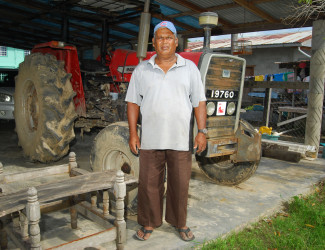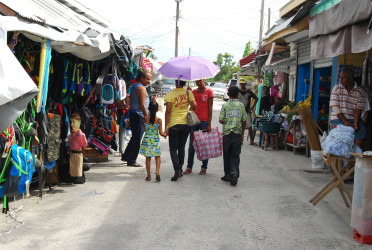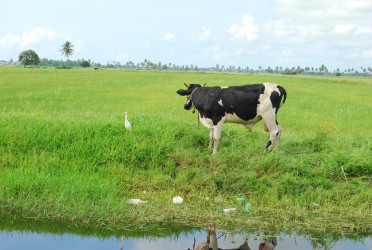It is not just the future of the rice industry that preoccupies significant numbers of residents of the Essequibo Coast but what the decline of the sector is likely to mean to communities which, in large measure, have never really contemplated any comparable options. When Stabroek Business visited the Essequibo Coast two weeks ago it met families, some of whom had been in rice cultivation for at least three generations. Changing direction is not easy.
There are, however, exceptions to the rule. There are a few family businesses that have expanded beyond rice. The Essequibo Coast still boasts thriving farms though rice and not those has been the backbone of such prosperity as is today evident in the Cinderella County.

These days some of the wives of Essequibo rice farmers have found their voices on the rice issue. They evince an intuitive wisdom that appears to cause them to place a greater value on their kitchen gardens. As of now they are winning the argument. For the moment their husbands, the rice farmers have no solution to the logjam over paddy payments and the future of the global rice market.
The farmers are keen to talk about the politics of the rice industry.
Nazir Mohammed is a Cotton Tree resident, a religious scholar and a man with a passionate concern over the future of rice cultivation of the Essequibo Coast. These days he works as Principal of the Al Madina Islamic School situated at Anna Regina having previously taught at St Stanislaus College, Anna Regina Secondary and the Essequibo Technical Institute. His thoughts, however, are never far away from farming a pursuit in which he has been involved for much of his life. Nazir farms fifty acres of land under rice cultivation at Anna Regina. Last week Stabroek Business sat down with him to ‘talk rice’ in an effort to understand the fortunes of the industry on the Essequibo Coast.
There is an uncomplicated bluntness about Mohammed. He recalls a 1992 visit to the Essequibo coast by the late Dr Cheddi Jagan during which he pleaded with farmers at an Anna Regina Market Square meeting not to embrace rice at the expense of all other alternative enterprises. ”Keep your cattle pastures your coconut estates………..continue to plant cash crops. You could be in danger if prices drop,” is what Mohammed said was the late President’s advice to farmers.
It seems, Nazir says, that not sufficient farmers listened and now they are paying the price.
With the termination of the PetroCaribe Agreement in November he believes that the sector could be on the threshold of crisis. Setting aside the challenge of selling tens of thousands of tons of additional rice, securing “the right price” is the real issue. “The prices we get cannot support our production costs, Mohammed says.


He heaps much of the blame for the current dilemma on the short-sightedness of the farmers. In better times, he says, profligate spending helped to lay the foundation for today’s situation. “Due to the high prices farmers reinvested heavily in the rice sector. Elaborate recapitalization saw Essequibo farmers become involved in the purchase of heavy machinery – combines and tractors that were used for approximately six to twelve weeks per year. Tractors were used three weeks per crop to plough the field and for the rest of the time they just lay idle.”
There were cases, he says, in which owners of tractors had to move several villages beyond their own to plough a field in order to make their purchases viable. “Similarly, several persons became owners of combines but had to move many miles to acquire jobs.” Combines, Mohammed points out, were not designed to travel long distances, hence additional maintenance costs associated with wear and tear.
High-maintenance situations have meant that some farmers are significantly indebted to spare parts dealers.
Mohammed challenges the wisdom of investments in combines and tractors by farmers who cultivate less than fifty acres of land and who, moreover, are renting rice lands. Tractors, he says, can cost anywhere between five million and thirteen million dollars whilst a new combine costs around thirty-eight million. A reconditioned one can cost around thirteen million. Use of the machinery means additional investment in the purchase of spare parts.

The “good times” which the rice industry used to enjoy made farmers favoured clients of commercial banks. As the circumstances of the industry have changed many farmers have been unable to fulfil their repayment obligations.
Mohammed believes that the rice industry can no longer evade the option of diversification. “The time has come for diversification and active research into the by-products of rice and the options to rice in the agricultural sector. In the short term the government will have to provide the support.”
Mohammed points out that cattle farming, cash crops, coconuts, fishing, logging and furniture making are pursuits with which Essequibians are not unfamiliar. To ease the burden on rice farmers Mohammed also recommends a temporary waiver of the drainage and irrigation fee of ten thousand dollars.
The question, he says, is whether Essequibo rice farmers are disposed to change. He does not appear to have made up his mind about that. Old habits die hard. For the moment at least they appear to be pinning their hopes on a less bumpy ride for the industry under the new political administration. There is, they believe, more effective Essequibo representation on the Guyana Rice Development Board these days though the challenge of accessing markets for the tens of thousands of rice that will become available once PetroCaribe comes to an end is still a conundrum to be dealt with. The farmers are far from sure as to which direction the industry is heading in.
How to reduce costs has become a constant issue for discussion among rice farmers on the Essequibo coast. Mohammed says that the farmers frequently overlook the role that better husbandry and effective drainage can play in reducing costs. He advocates a more aggressive education regime for farmers in areas that include the use of fertilizer and recommends thorough soil tests with a minimum frequency of once every three years. Farmers on the Essequibo Coast, according to Mohammed are also concerned that they have to pay more for fertilizer and chemicals and have begun to advocate subsides.
Not least among the farmers’ concerns are the issues of water resources management and relations with millers. In the latter instance, Mohammed says, many rice farmers on the Essequibo Coast hold the view that millers are unmindful of their obligations to them.
Mohammed told Stabroek Business that a farmer may take his paddy to miller A for grading to be told that his paddy has a 16% moisture content. The same paddy would be taken to miller B and the moisture content would be declared to be 22%. He says that while representatives of the GRDB are present at the mills during the grading exercise, there are instances in which farmers cannot properly verify the declared moisture content. While grading results should immediately be made available to farmers there are instances in which they are required to return for those results the next day, Mohammed says. The implication here is that results are sometimes tampered with. There exists a great deal pf mistrust amongst the key players in the sector.
Management of water resources has become an area of serious inefficiency in the rice sector. “We are not getting anywhere near full returns for the money being spent on water resources,” Mohammed says. “Water inlets to villages and to rice lands have been allowed to deteriorate. Some are completely clogged. Some leak even when they are closed,” he says.
Water is the ‘life blood’ of rice cultivation and Mohammed says that calls from Essequibo farmers for “a predictable “water schedule” have fallen on deaf official ears. In the absence of such a schedule the water supply infrastructure has been continually vandalized and sections of it have fallen into disrepair. While there are laws that stipulate penalties for vandalizing the water infrastructure, enforcement is weak.
Rohini Ram belongs to a rice-farming family. Her father used to cultivate a ten-acre plot and that, along with a kitchen garden sustained the entire family. What has changed over the last twenty years, she says, is the cost of living. It takes more these days to support a family. “These days farmers can’t afford to wait. They need their money to survive.”
Like Mohammed, Rohini believes that change is the challenge and that some Essequibo farmers will remain in the sector “even if the price drop to five hundred dollars a bag.” It’s a case of old habits dying hard.





